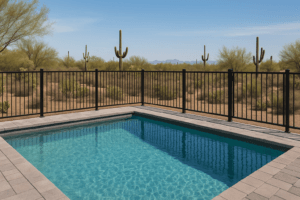Many homeowners struggle with ensuring their pool area is both safe and stylish. That’s where we come in, offering this comprehensive guide to DIY pool fences. Specifically crafted for homeowners in maricopa County, this resource will guide you step-by-step to a safer pool environment.
Contents
- 1 Understanding the Necessity of Pool Fencing
- 2 Exploring Different Types of Pool Fences
- 3 Preparing for Installation: Tools and Materials
- 4 Planning Your Fence Layout
- 5 Installing the Fence Posts
- 6 Attaching Fence Panels
- 7 Incorporating a Gate for Accessibility
- 8 Enhancing Safety Features
- 9 Maintaining Your Pool Fence
- 10 When to Call in Professionals
- 11 Conclusion
Understanding the Necessity of Pool Fencing
First and foremost, pool fencing isn’t just about compliance. It’s about creating a secure space for family, friends, and even pets. Safety should always be our top priority, and a well-installed pool fence can prevent countless accidents.
For homeowners, recognizing the significance of a pool fence is crucial. Whether you have children, frequent young visitors, or simply want peace of mind, a fence acts as a proven barrier against unwanted pool access.
Exploring Different Types of Pool Fences
When considering a pool fence, we have a variety of options such as mesh, glass, or wood. Each material offers distinct benefits and aesthetics, allowing us to match the fence with our home style seamlessly.
For example, glass fencing provides a sleek look and maintains visibility, while mesh is cost-effective and easy to install. Understanding these options aids us in making an informed decision that aligns with our needs and budget.
Preparing for Installation: Tools and Materials
A successful DIY project begins with preparation. Gather necessary tools such as a drill, measuring tape, and post hole digger. Having everything on hand saves us time and potential frustration.
Additionally, ensure you purchase all required materials including fence panels, posts, and caps. Double-checking these purchases ensures we won’t run into unexpected delays once we start the project.
Planning Your Fence Layout
Before we dig, it’s crucial to plan. Start by sketching a layout or using digital tools to visualize the space. Identifying pool edges, pathways, and entry points will help us determine precise measurements.
By mapping out the fence, we proactively address potential issues with uneven ground or awkward fittings. Thoughtful planning smooths the installation process and guarantees a more professional finish.
Installing the Fence Posts
With the layout set, it’s time to install the posts. Dig holes at appropriate intervals, ensuring they are deep enough to support the fence’s weight securely. Consistency in depth and spacing leads to a stable structure.
Once the holes are ready, place and level each post before securing it with concrete. Patience in this step pays off, providing a firm foundation for the entire fence.
Attaching Fence Panels
After the posts are solidly set, we can move on to attaching the panels. This stage requires precision to ensure each panel is straight and secure. Using clamps or a second pair of hands can facilitate the process.
Aligning and affixing each panel requires careful attention, but the result will be a neat, uniform look. Proper attachment prevents sagging and enhances the fence’s durability.
Incorporating a Gate for Accessibility
Every pool fence needs a well-positioned gate for easy access. Choose a location that balances convenience with safety, keeping in mind how often different areas are used.
Installing a self-latching, self-closing gate adds an extra layer of security. This feature ensures the gate remains closed when unattended, maintaining our safety goals.
Enhancing Safety Features
- Height Considerations: A taller fence can offer enhanced security and privacy, adhering to any local regulations on minimum height.
- Non-Climbable Design: Opt for designs that discourage climbing, reducing the risk of children accessing the pool area without supervision.
- Locking Systems: Invest in a reliable locking system for the gate to ensure only authorized individuals have access.
- Clear Sightlines: Maintaining visibility from the house to the pool helps in monitoring activity and reacting promptly if needed.
- Material Durability: Select weather-resistant materials that withstand local climate conditions for long-term safety and appearance.
Maintaining Your Pool Fence
Regular maintenance of our pool fence ensures longevity and consistent safety. Begin by checking for any signs of wear, rust, or damage and address these promptly.
Additionally, clean the fence periodically to maintain its appearance and functionality. This simple upkeep can add years to the life of the fence while ensuring ongoing protection.
When to Call in Professionals
While DIY can be rewarding, some situations call for professional assistance. If you’re uncertain about legal requirements, hiring an expert ensures compliance and a polished end result.
Additionally, if the installation becomes too challenging, our team is here to step in. Professional help can save time and stress, providing peace of mind.
Conclusion
Ready to ensure your pool area is as safe as it is beautiful? Reach out to Pool Safety Fencing by phone at 480-771-8026 or Request a Free Quote today!




